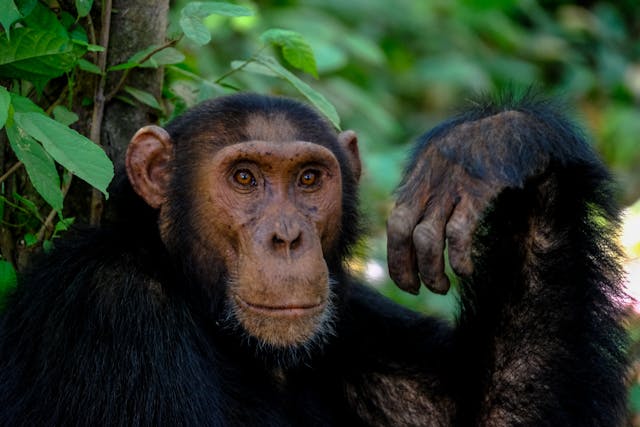
What is the last common chimp-human ancestor? The last common chimp-human ancestor was probably about seven million years ago, possibly, although there are no remaining fossils of this animal.
It is often mistakenly said that humans evolved from chimpanzees, but this is not the case. Both chimpanzees and humans evolved from a common ancestor in the same way that whales and hippos evolved from a common ancestor. (Did you know that whales and hippos were related? They shared a common ancestor about 55 million years ago.) We evolved alongside all of the other groups of apes. It is possible to know that humans and chimps shared a common ancestor because we share so much of our DNA. In fact, 98.8% of our DNA is identical. This identical DNA makes the proteins in our bodies do the same thing and we both have traits that other animals don’t have. The ability to see red, for one example. However, since we both descended from this common ancestor, we have evolved in different ways, leading to the 1.2% difference between us. And that 1.2% difference is significant because it leads to all of the things that make us human. These are obvious things like language and complex reasoning. The common ancestor is not just ours, but it is the common ancestor of all the proto humans that have existed. We are just one species of 21 different species of human, and eight of them probably lived at the same time.
It is possible to work out from the number of differences between the two species how long ago they shared an ancestor. Scientists can look at how often mutations appear in a species. If they know this, they can work out how many generations it would have taken for 1.2% of the DNA to mutate. This calculation gave scientists the figure of 6 million years. However, recently, scientists have realized that humans mutate at half the speed they previously thought, so they have revised their estimate up to about 10 million years. It seems that human and chimp DNA would diverge by about 0.1% every million years.
When chimps and humans split is unknown, but thought to be about 6 to 10 million years ago. Once the split happened, each different species started to evolve and diverge depending on its surroundings. Remember, it wasn’t chimps and us that split, because homo sapiens didn’t evolve until about 300,000 years ago. It was two types of apes that split. One type probably lived in forests and became adapted for tree living. These probably evolved into the chimps. The other species probably lived on the grasslands and savannahs and became adapted for that kind of environment. These species were probably the early hominids.
No fossils of the chimp-human ancestor have been found, but there are some candidates. Anthropologists thought that whatever the ancestor was, it would be much more similar to a chimpanzee than it is to us. That belief arose because the experts assumed that we have diverged more from this ancestor than chimps have done because we are far more specialized and have had to adapt more. They believed that the ancestor was probably short, could climb and swing from trees, and knuckle walked. However, this opinion changed when fossils of an ape called Ardipithecus ramidus were found. This species has been dated to just before humans and chimps split and is likely to still have some of the characteristics of our joint ancestor. It was adapted to walking on two legs, but could also climb and live in the trees. It was not an efficient two-legged walker, but it could do it. It didn’t use its knuckles to walk. It had stronger teeth with more enamel than we do, but not teeth adapted for eating fruit, as chimpanzees have. Their skull was probably smaller than ours but larger than a chimp’s. It probably mostly lived in the forest, but would venture out onto the grasslands. It probably had a complex social structure and perhaps some kind of very basic communication.
It is not unusual that there are no fossils because our common ancestor would have lived in the forests. Dinosaurs, for example, leave fossils if they were in the right conditions and don’t leave fossils if they aren’t, obviously. We tend to get the survivor bias fossils because there are far more of some kinds than others. Our common ancestor lived in forests, which have soft, fertile soils that recycle dead animals very quickly. And this is what I learned today.
Sources
https://www.livescience.com/7929-human-evolution-closest-living-relatives-chimps.html
https://en.wikipedia.org/wiki/Chimpanzee%E2%80%93human_last_common_ancestor
https://australian.museum/learn/science/human-evolution/sharing-a-common-ancestor/
https://en.wikipedia.org/wiki/Ardipithecus_ramidus
https://www.livescience.com/how-many-human-species.html
https://www.nbcnews.com/id/wbna55395491
https://www.livescience.com/37943-great-ape-genomes-sequenced.html
https://www.science.org/doi/10.1126/science.abb4363
Photo by Francesco Ungaro: https://www.pexels.com/photo/photo-of-primate-1238347/
